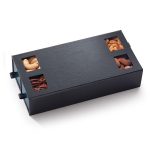
In the rapidly evolving world of virtual reality, the first physical interaction a customer has with their new device isn’t the headset itself—it’s the packaging box. VR device packaging boxes have transformed from simple cardboard containers into sophisticated brand ambassadors that set the tone for the entire user experience. These carefully engineered boxes serve multiple purposes: protecting delicate technology, communicating brand identity, and building anticipation for the immersive journey ahead.
The modern VR packaging box represents a perfect marriage of form and function. Unlike traditional electronics packaging, VR boxes must accommodate uniquely shaped components while maintaining structural integrity. High-density foam inserts, custom-molded trays, and magnetic closures have become industry standards, ensuring that sensitive lenses, controllers, and sensors arrive in pristine condition. The packaging itself has become part of the product ecosystem, with many companies designing boxes that can be repurposed as storage solutions or display cases.
Brand storytelling begins the moment customers lay eyes on the packaging. Leading VR manufacturers use premium materials, sophisticated color schemes, and minimalist design to convey technological sophistication. Matte finishes with strategic glossy accents, embossed logos, and precisely calculated weight distribution all contribute to creating a premium unboxing experience. The packaging becomes a physical manifestation of the brand’s commitment to quality and attention to detail.
Sustainability has become a crucial consideration in VR packaging design. As consumers become increasingly environmentally conscious, manufacturers are responding with eco-friendly solutions. Recycled cardboard, biodegradable foam alternatives, and soy-based inks are becoming commonplace. Some companies have even introduced seed paper inserts that can be planted after unboxing, turning the packaging into a living reminder of the brand’s environmental commitment.
The unboxing sequence is carefully choreographed to build excitement and facilitate easy setup. Layer by layer, customers discover different components arranged in logical order, often with visual guides and QR codes linking to setup tutorials. This thoughtful organization reduces initial setup frustration and helps users feel progressively more connected to their new device. The packaging becomes a silent teacher, guiding users through their first interaction with the technology.
Beyond protection and presentation, VR packaging serves as a crucial marketing tool. Social media platforms are filled with unboxing videos and photos, making the packaging design an extension of the company’s digital marketing strategy. Share-worthy packaging can generate organic buzz and free advertising, with unique opening mechanisms and surprise elements encouraging users to document and share their experience.
As VR technology becomes more mainstream, packaging design continues to evolve to meet diverse consumer needs. From compact designs for travel-friendly models to elaborate collector’s editions for gaming enthusiasts, the packaging adapts to different market segments. The future may bring even more innovation, with smart packaging incorporating NFC chips for instant setup or augmented reality elements that come to life when viewed through smartphone cameras.
Ultimately, the VR device packaging box represents the bridge between the digital and physical worlds. It’s the tangible representation of virtual possibilities, the carefully crafted introduction to immersive experiences, and the first chapter in the user’s journey with their new device. In an industry defined by digital innovation, the physical packaging remains a critical component of the overall product experience—one that continues to push boundaries and exceed expectations.




Leave a Message